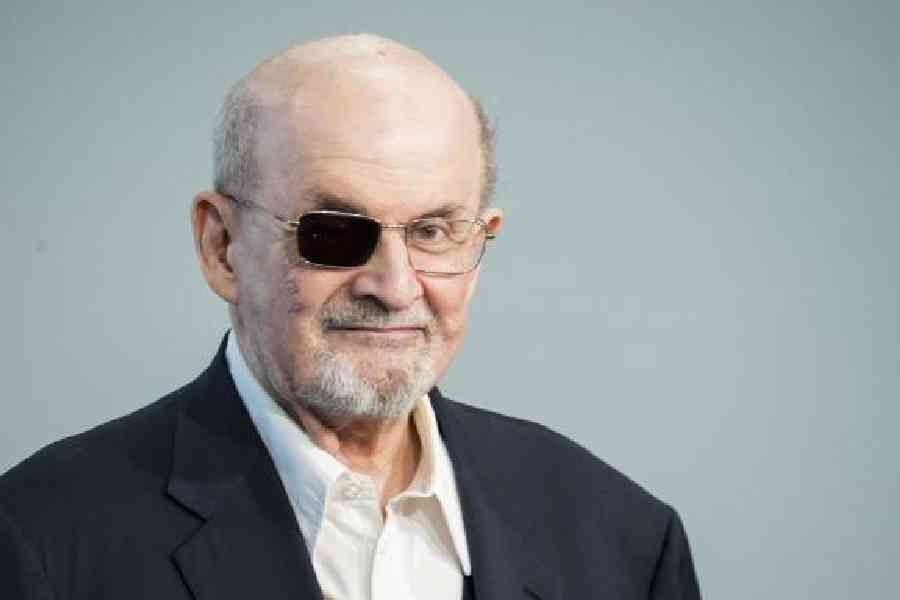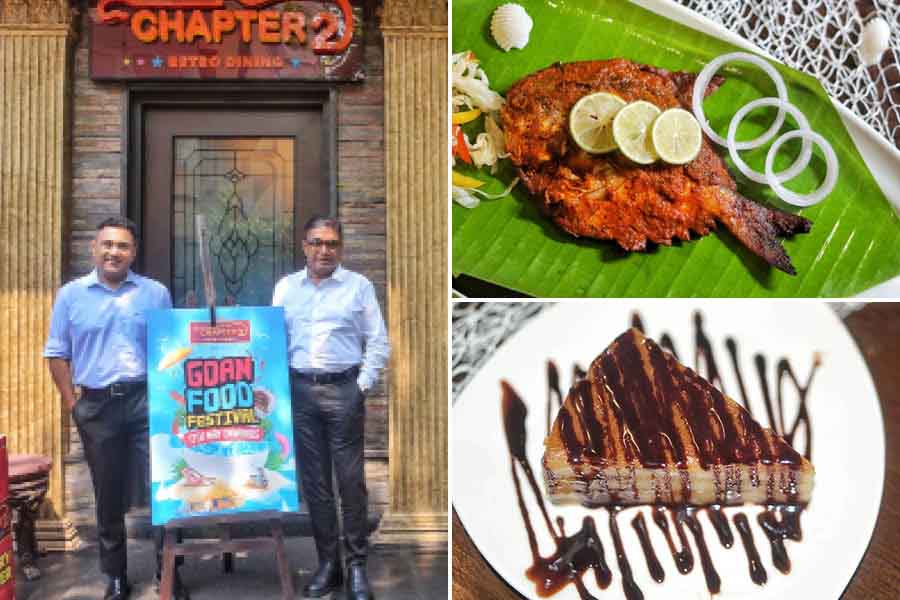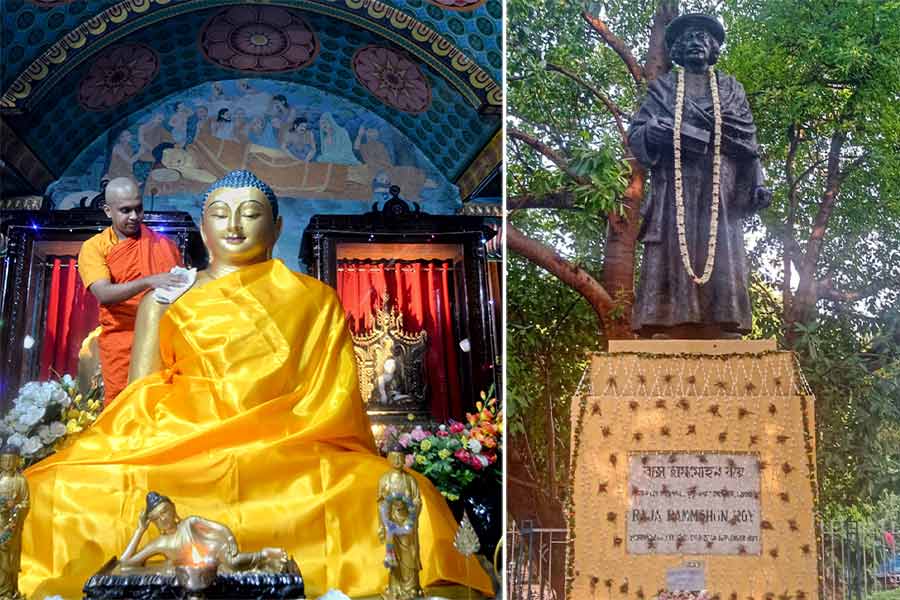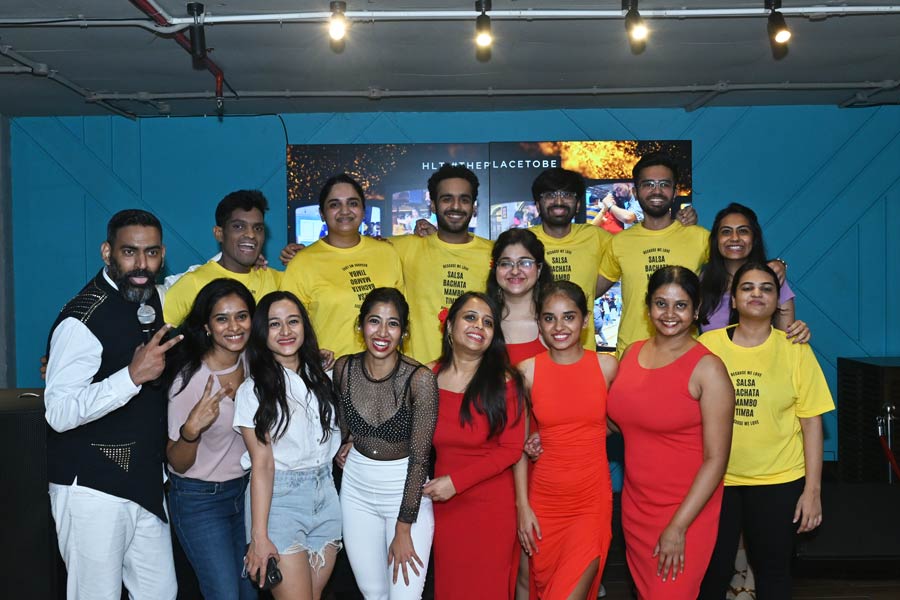Penned during a time when he was fighting for his sight and his life too, Salman Rushdie’s latest novel Knife consists of “meditations after an attempted murder”. It is a result of 27 seconds of an encounter of the most intimate kind, the knife thrusting in and out of him 15 times, slashing and bloodying his new Ralph Lauren suit, and almost killing him, it was an intimacy of a body-to-body contact, a grappling that was at its base, an embrace of death.
As Rushdie points out, 27 seconds is not so short a time. You could, if you wished, recite The Lord’s Prayer in 27 seconds, or one of Shakespeare’s sonnets, and that the assailant might have been happy during this time of intimacy. But then he was dragged off Rushdie and was pinned down, his 27 seconds of fame were over. He was nobody again.
The “nobody” will go on trial for attempted murder sometime in 2024. It is not clear if Rushdie will testify. He writes, though, that if he was “obliged to go to court and testify, I would want to tell him [the assailant] something like this:
“Our lives touched each other for an instant and then separated. Mine has improved since that day while yours has deteriorated. You made a bad gamble and lost. I was the one with the luck.”
In Knife, we never learn the name of the assailant. Rushdie explains he did not want to use his name, describing him as the “Asinine man who made Assumptions about me, and with whom I had a near-lethal Assignation.”
Although oblivious to the indomitable and surreptitious presence of the fatwa placed on his head 33 years ago — Rushdie has waved it away as no longer a threat in interviews since the late 1990s — the demons still pursued him. Some of us have heard him say, “I am getting on with my life.”
Rushdie was always aware that some fundamentalist might try to kill him but that never stopped the writer from creating stories that spoke out. And then suddenly, bang in the midst of a festival crowd, in a hive of activity in the innocuous upstate New York county of Chautauqua, where 2,500 members of the public were waiting to hear him speak on August 12, 2022, a man sitting in the audience vaulted onto the stage and kept stabbing him for 27 long seconds while astonished witnesses were left stunned. Just when hundreds and thousands of readers were almost lulled into believing, just as Rushdie had been, that the fatwa had faded into the twilight, the reality of the death sentence seems to have risen from a flicker of dusk.
For his unflinching courage and commitment to talking back to masculinist domination and fundamentalism, after 33 years, Rushdie was assaulted brutally and suffered an injured liver and lost an eye. His 24-year-old attacker, Hadi Matar, resident of Fairview, New Jersey, of Lebanese descent, sympathiser of the Iranian military, who committed the premeditated, heinous assault on Rushdie, is just the kind of person who was waiting to target this author for his truth-telling.
In this book, Rushdie refers to his would-be assailant as “The A”. He must remain “The A” (the insignia for an expletive) because he had not bothered to educate himself about the man he wanted to kill, having read barely two pages of Rushdie’s writing or watching a couple of YouTube videos of him speaking. Rushdie concludes that the attack was obviously not about The Satanic Verses. And in Knife he sets about finding out what it was about.
Rushdie grapples with the questions, why didn’t he fight back, why didn’t he defend himself, why didn’t he run, why did he stand there like a pinata and get smashed? He explains that on that beautiful morning, violence came running at him, a 75-year-old, and his reality fell apart, and it is “not very surprising that in the few seconds available to me I didn’t know what to do”. This “Mr A” was a 24-year-old man knifing Rushdie’s left hand, severing all the tendons and most of the nerves, inflicting two deep stab wounds in the neck, and another on his face, a line of wounds on his chest, a cut on his upper right thigh, a wound on the left side of his mouth, and one along his hairline. Then there was the knife in the eye, which Rushdie calls the cruellest blow, the blade going all the way to the optic nerve and severing it.
The book consists of two parts: The Angel of Death and The Angel of Life.
In the first part he describes the attack, and his wife, Rachel Eliza Griffiths, an African-American poet — how they met, how they began living together, learning that she had always wanted to be a novelist and that she had written fiction all her life, long before she had written poetry, and was held in high esteem by her fellow poets. Rushdie and Eliza decided to be private people. They stayed off social media and for five years and more, flew completely “under the radar” showing that it was still possible to lead a happy private life.
“Cutting that life apart, came the Knife,” Rushdie states with enormous impact.
Eliza did not accompany him to the event. She had stayed back in New York. She watched the attack on the CNN screen, rumours swirling around her: Rushdie was dead. No, he had been knifed but was not killed. No, he had risen to his feet and left the stage. In London, Rushdie’s family were desperately calling Eliza for news — his son Zafar, and sister Sameen. They learned he had been flown to the nearest hospital. There was little chance he would live. They all wept.
Eliza called Rushdie’s literary agent, Andrew Wylie. “Andrew was crying,” Rushdie writes. “We had been friends for thirty-six years… he had been my strongest and most loyal ally.”
Inside the operation theatre, multiple surgeons worked on different wounded parts, his neck, right eye, left hand, liver and abdomen. The surgery took eight hours. In the end, he found himself on a ventilator. Alive. The ventilator, he says, felt like the tail of an armadillo when it was eventually removed from his throat.
When Eliza and a few others arrived to see him, they saw what he could not see: his slashed cheek and neck were held together by metal staples, a horizontal gash along the neck also held in place by staples, the neck “grotesquely swollen and darkly bloodied”, his left hand held stiffly in a splint. When the nurse came to dress his ruined eye, they saw it looked like a sci-fi movie special effect, the eye “distended, bulging out of its socket and hanging down on my face like a large soft-boiled egg”. They knew that his liver was damaged and a part of his small intestine was removed.
Eliza did not let him look into a mirror. For many weeks, “I had no idea how awful I looked,” writes Rushdie. Doctors would say that he was looking much better, and “I believed their lies because I wanted to”.
After about 10 days, he walked out of the hospital room, a nurse by his side, moving with the help of a walking frame. After that every day he walked a little better.
Part One also takes us into Rushdie’s rehab, three rounds of it, and then his worries about post-traumatic stress disorder. In the day, he tried to stay calm, collected, and optimistic, but at night “when I slept all my defenses fell away, and the night horrors came for me”.
After more than six weeks in two hospitals, Rushdie was ready to return to the world. Part Two takes us through the chapters Homecoming, The A., Second Chance, and Closure?.
Rushdie was always blessed with loyal friends, one of whom offered him and Eliza their loft apartment in New York City, where he rested his head on a pillow that did not belong to a hospital.
Lying at the core of Knife is Rushdie’s innermost desire to confront his would-be killer, The A, whom he met for only 27 seconds, describing him in this way: “His ears stick out … he bears a slight resemblance to the tennis player Novak Djokovic.”
Rushdie never wanted to meet The A, preferring to construct an imaginary interview with him within the Chautauqua County Jail. His assailant sits in front of him on a metal chair, handcuffed and shackled.
Rushdie doesn’t want to be “too friendly,” or “too unfriendly”. He just wants “to open him up, if I can. Because a real meeting is improbable — make that impossible — I have to imagine my way into his head. I have to try to make him up, make him real.”
But The A has not expressed remorse. Rushdie is not looking for an apology either. But he needs answers: Has The A had second thoughts? Is he proud of himself? Would he do it again? Does he hope to travel to Iran to collect the prize an organisation there has offered, after he has served his sentence?
Here is a snippet from the imaginary conversation:
The A: “You are only a little devil… But even a little devil is a devil.”
Rushdie: And devils must be destroyed?
The A: Yes.
And later in the imagined interview:
The A: You have a bad mind. A mind like a butterfly. It can’t say focused on what matters. It’s an American mind.
Rushdie: But I am from India originally. From a secular Indian Muslim family. I have an Indian mind and later a British mind and now, maybe, yes, also an American mind.
The A: Secular is a synonym for “liar”. It is a sickness.
Rushdie explains why he wrote Knife in the first person: “Because when somebody wounds you fifteen times it definitely feels very first-person. That’s an ‘I’ story. And now, I told myself, it’s also an ‘eye’ story.”
In the chapter Closure?, Rushdie understood that three things had happened towards coming to terms with the murderous attempt — the passage of time that “might not heal all wounds, but it deadened the pain and the nightmares went away”, the therapy “helped me more than I am able to put into words”, and “the third was the writing of this book”.
“These things did not give me ‘closure’,” he writes, but “they did mean that the assault weighed less heavily on me than before”. The result? Rushdie was not sure if he wanted to, or needed to, confront The A in open court.
Yet, there was still one more thing to do. He needed to return to the scene of the crime. Thirteen months after the assault, he returned to the amphitheatre at Chautauqua “to feel myself standing up again, healthy and strong… in the place where I had fallen down and very nearly dead… I hoped it would feel like a rite of overcoming, and help me to leave that terrible day behind.”
He went, and stood right where he fell, but refrained from reciting, he says, the lines from W.E. Henley’s Invictus: “Under the bludgeonings of chance/ My head is bloody, but unbowed.”
As he stood at the spot, he realised that “a burden had been lifted from me somehow, and the best word I could find for what I was feeling was lightness. A circle had been closed, and I was doing what I had hoped I could do here — I was making my peace with what had happened, making my peace with my life. I stood where I had almost been killed, wearing, I have to tell you my new Ralph Lauren suit, and I felt... whole.”
“I could see that this was good for you,” Eliza said, “and that it made it good for me too.”
And, he wrote: “I remembered the question I had asked myself after the attack: could our happiness survive such a blow? Standing there on the stage of the Chautauqua amphitheatre, I knew the answer. Yes, we had reconstructed our happiness.”
In the conclusion of Rushdie’s book, Joseph Anton (2012), his personal account of what it was to live in hiding for well over a decade, a tale that was devastating in its intimacy and its volatility, Rushdie wrote: “This in the end was who he was — a teller of tales, a creator of shapes, a maker of things that were not. It would be wise to withdraw from the world of commentary and polemic and rededicate himself to what he loved most, the art that had claimed his heart, mind and spirit. Ever since he was a young man, and to live again in the universe of once upon a time, of kan ma kan, it was so and it was not so, and to make the journey to the truth upon the waters of make believe.”
And Rushdie had kept his ferocious spirit strong and burning. After six months from that horrible August day when ‘The A’ tried to snuff out his life, Rushdie’s volition was unwavering, his will to write unflinching. He almost predicted the reality that was about to strike him, in the blinding of the protagonist, Pampa Kampana, of his most recent novel Victory City.
Julie Banerjee Mehta is the author of Dance of Life and co-author of Strongman: The Extraordinary Life of Hun Sen. She has a PhD in English and South Asian Studies from the University of Toronto, where she taught World Literature and Postcolonial Literature. She currently lives in Calcutta and teaches Masters English at Loreto College.






